Steyr Mannlicher - Home of Steyr Firearms in Steyr, Austria
| Quick Naviation: | Steyr History | Steyr Weapons Hall | Steyr Arms | Steyr Engraving Video | Guns of Steyr | U.S. Imports |
| Steyr Mannlicher is an Austrian firearms manufacturer with a history of fine craftsmanship and innovation. The following history and details of the Steyr Mannlicher company was compiled following a visit to the Steyr Mannlicher factory in Austria by GunsForSale.com staff. |
History
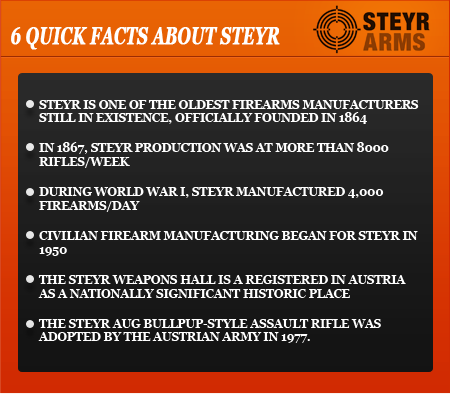
The roots of Steyr Mannlicher grow deep into the bedrock of European arms manufacturing, tracing the company back hundreds of years. The recognized founder of Steyr, Josef Werndl, inherited his father’s firearm manufacturing company in the mid-1800’s.
Yet, Werndl came from a family with a rich tradition of firearms production. So, it is unknown exactly how far back the Steyr company dates. However, it is widely accepted that Steyr is one of the oldest firearms manufacturers in Europe that is still in operation today.
Werndl founded “Josef und Franz Werndl & Comp. Waffenfabrik und Sägemühle in Oberletten” on April 16, 1864, which was the forerunner of Steyr Mannlicher.
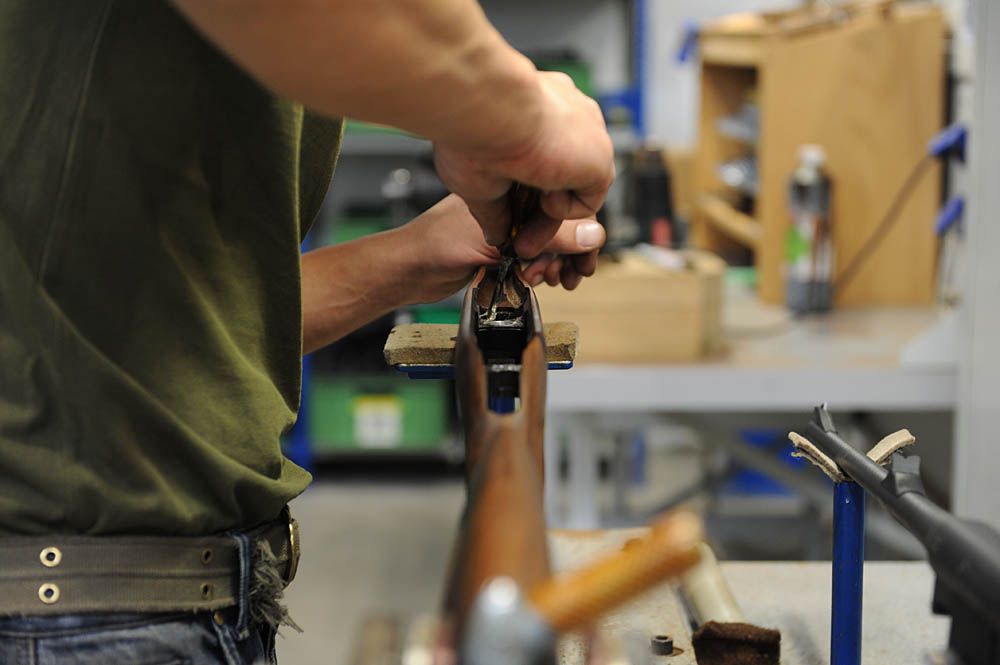 Beginning in 1867, hundreds of thousands of rifles were delivered to the Austrian-Hungarian Empire’s Central Army Administration by Steyr. More than 8,000 rifles every week were produced by almost 6,000 employees.
Beginning in 1867, hundreds of thousands of rifles were delivered to the Austrian-Hungarian Empire’s Central Army Administration by Steyr. More than 8,000 rifles every week were produced by almost 6,000 employees.
Rifle designer Ferdinand Ritter von Mannlicher developed a bolt action rifle that Steyr sold to the Austrian-Hungarian Empire in 1885. The new rifle was very well received by the army, and by 1889, Steyr employed more than 10,000 workers.
Prior to World War I, the Steyr factory was unrivaled by any other firearms manufacturer in the world. In 1912, work began on a new factory, which allowed Steyr to expand capacity and modernize its techniques. The new factory was completed in 1914.
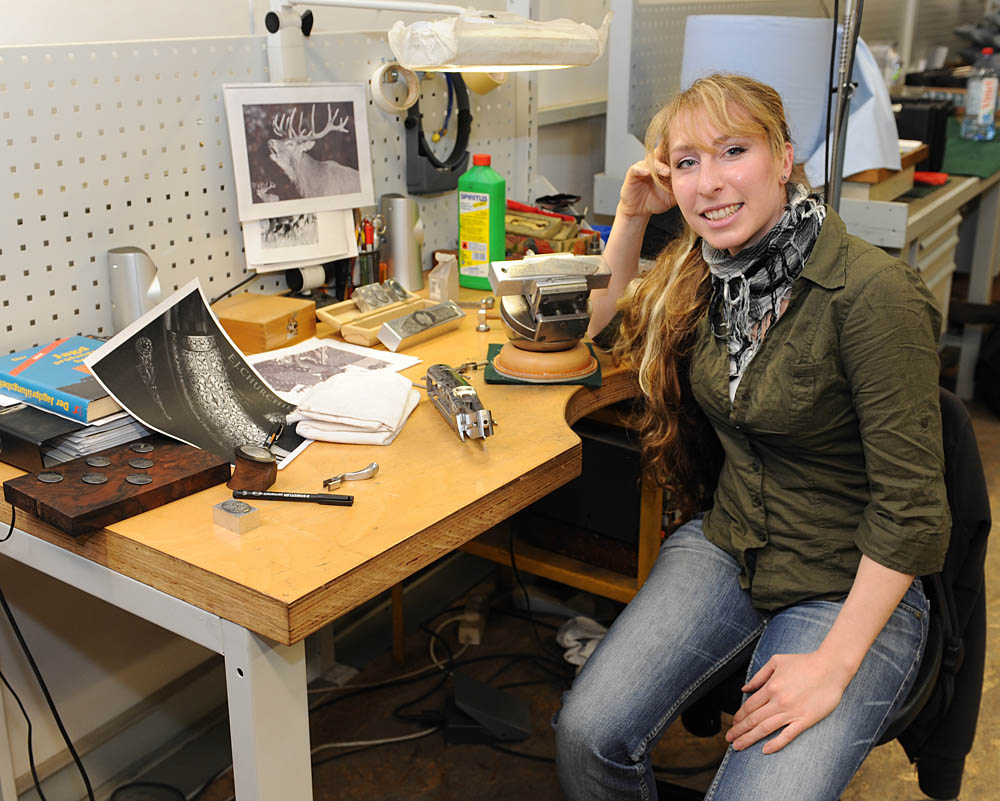 As Austria gained independence, Steyr began to equip the country’s armed forces with the StG 58 assault rifle.
As Austria gained independence, Steyr began to equip the country’s armed forces with the StG 58 assault rifle.
1914 was also the year Europe tumbled into World War I. When hostilities erupted, Steyr produced some 4,000 firearms a day. Employment expanded to more than 15,000 employees, and production moved beyond firearms to include airplane engines and bicycles to help the war effort.
By 1915, Steyr was the largest manufacturer of firearms in the world.
At the end of World War I, firearms production was severely restricted, and Steyr faced dire financial difficulties. Steyr converted their production lines to manufacture automobiles. Prior to the onset of World War II, however, restrictions on firearms production were loosened, and Steyr began making guns again.
After World War II, US Army General Mark W. Clark was the US High Commissioner of Austria and assisted in the negotiations for the Austrian treaty in London and Moscow. Steyr credits General Clark with ensuring Steyr was located in the western allies portion of Austria in the years after the fall of Nazi Germany. Additionally, Steyr credits General Clark with approval for the company to resume firearms manufacturing.
In 1950, Steyr began manufacturing firearms for civilians, which are now a significant portion of the Steyr production. Initially, the Mannlicher-Schönauer full stock hunting rifle was manufactured, which proved to be very popular.
Development of new firearms continued in the 20th century, with a new hunting rifle design in the 1960s and new military weapons in the 1970s. It was during the 1970s that the StG 77, or Steyr AUG, was developed.
Today, Steyr continues the tradition of fine craftsmanship and innovation in the firearms industry.
Steyr Weapons Hall
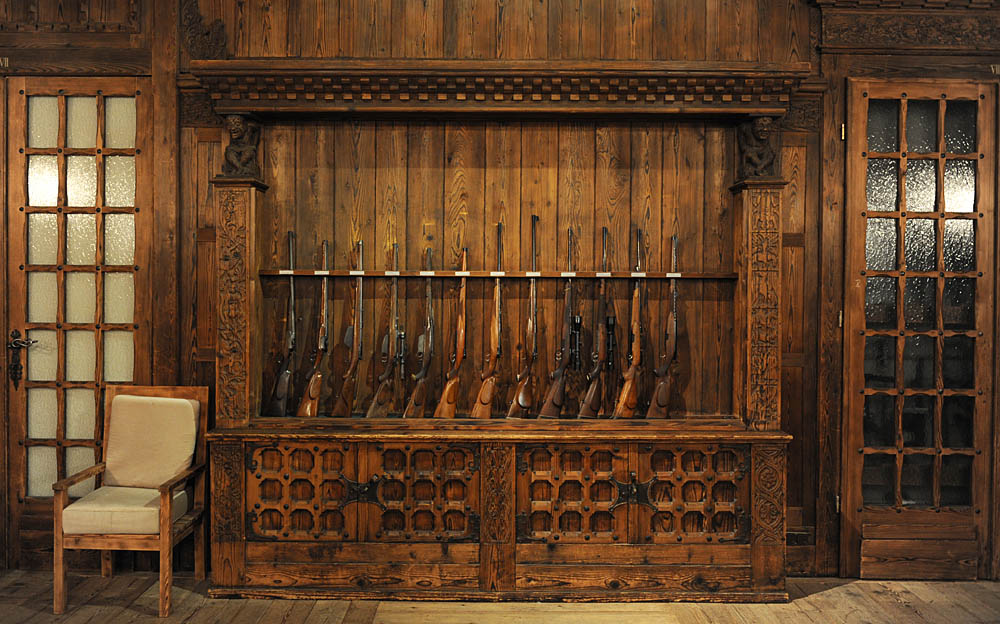 The Steyr Weapons Hall is registered in Austria as a nationally significant historic place. It was built by Russian prisoners of war during World War I. The Weapons Hall was designed in the traditional Nordic style. Years later, when the Steyr plant moved, the Weapons Hall was moved in its entirety to the new facility.
The Steyr Weapons Hall is registered in Austria as a nationally significant historic place. It was built by Russian prisoners of war during World War I. The Weapons Hall was designed in the traditional Nordic style. Years later, when the Steyr plant moved, the Weapons Hall was moved in its entirety to the new facility.
The Weapons Hall features recessed show cases that are used to display Steyr firearms from 140 years of production. The wooden walls are all hand-crafted and display incredible detail and ornamentation.
Steyr Arms
Steyr Arms is the modern home of Steyr-Mannlicher in the United States. Located in Trussville, Alabama, Steyr Arms occupies a 25,000 square foot facility that includes an underground shooting range, gunsmithing facilities and testing facility.
The first distributor of Steyr firearms in the United States was Abercrombie & Fitch.
In addition to being the sole importer and distributor of firearms manufactured by Steyr-Mannlicher, Steyr Arms acquired Merkel USA in January 2010. With this acquisition Steyr Arms is the sole U.S. importer and distributor of Merkel shotguns, rifles, drillings and combination arms. Additionally, Steyr Arms is the sole importer and distributer of the Anschutz Sporting Rifle Series.
Steyr Engraving Video
Guns of Steyr
StG 77 – Steyr AUG
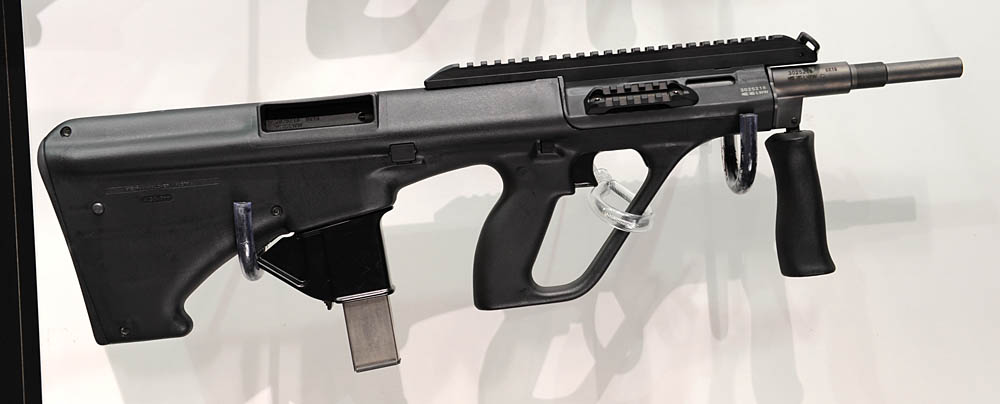 The Steyr AUG is a bullpup-styled assault rifle introduced in 1977. AUG stands for “Armee Universal Gewehr,” or Universal Army Assault Rifle. The AUG is chambered for the 5.56 NATO.
The Steyr AUG is a bullpup-styled assault rifle introduced in 1977. AUG stands for “Armee Universal Gewehr,” or Universal Army Assault Rifle. The AUG is chambered for the 5.56 NATO.
There are several variations of the AUG with the A1/A2 being the basic models. They feature cold hammer forged, quick change barrels in both 16” and 20” variations. The A1 AUG has a built-on optic, while the A2 features a Picatinny rail on the receiver to accept virtually any modern optic.
The AUG A3 is a more modular version of the AUG with multiple Picatinny rails on the firearm, which allows for the addition of white lights, IR illuminators, lasers and other accessories used by the modern warfighter. Additionally, the A3 has four barrel options: 14.5”, 16”, 18” and 20”.
Unlike many other assault rifles, the AUG does not have a selector switch for fire modes. Press the trigger back halfway to a “clearly felt point” fires a single round, while pressing all the way to the rear fires the gun in full auto. In full auto mode, the AUG fires approximately 680-750 rounds/minute.
A 9mm version of the Steyr AUG is made in both the A1 and A3 variations. Both variations use a 12.8” barrel and 25 round magazines. Unlike the gas operated system in the 5.56 NATO versions, the 9mm AUG uses a blowback design. Rate of fire is 650-720 rounds per minute in full auto.
The armed and special forces of more than 30 countries use the Steyr AUG.
M-A1 Steyr Pistol
The Steyr M-A1 pistol is a full sized duty handgun chambered in both 9mm and .40 S&W. The M-A1 uses a high-end polymer frame with grip that claims to have “unsurpassed ergonomics.”
The handgun has a 4” barrel and weighs about 27 ounces unloaded. Standard capacity is 15 rounds for the 9mm and 12 rounds for the .40 S&W.
The pistol is available in full size (M), compact (C), and subcompact (S) sizes. All three share a feature that originated at Steyr: instead of the rails that the slide rides on being molded into the frame, they are part of a metal-injection-molded component that is separate and distinct from the frame. Steyr says this substantially increases durability.
One of the distinguishing characteristics of the M-A1 is the sights. The front and rear sights form a trapezoid, which Steyr claims draws the eye naturally down the sights and onto target. An optional night sight system is also available.
Steyr HS .50
 For the ultimate big bang, Steyr produces the HS .50 rifle chambered for the .50 BMG cartridge. Designed for long range shooting, the HS .50 is a magazine fed, bolt action gun that provides “excellent accuracy” to 1500 meters.
For the ultimate big bang, Steyr produces the HS .50 rifle chambered for the .50 BMG cartridge. Designed for long range shooting, the HS .50 is a magazine fed, bolt action gun that provides “excellent accuracy” to 1500 meters.
The HS .50 has a 33” cold hammer forged barrel. The barrel uses a high efficiency muzzle brake to reduce felt recoil. Total weight is just under 29 pounds.
The HS.50 has a to stage trigger set at 4 pounds from the factory. The receiver is topped with a Picatinny rail for the addition of an optic.
